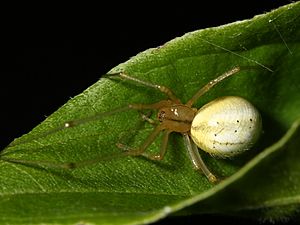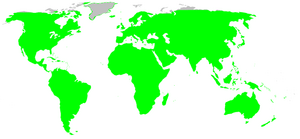Tangle-web spiders facts for kids
Quick facts for kids Tangle-web spiders |
|
|---|---|
 |
|
| Enoplognatha ovata | |
| Scientific classification | |
| Diversity | |
| 124 genera, 3028 species | |
 |
Theridiidae, also known as tangle-web spiders, cobweb spiders, or comb-footed spiders, are a huge family of spiders. They are a type of araneomorph spider, which means they have fangs that move like pincers. These spiders were first described by a scientist named Carl Jakob Sundevall in 1833. There are over 3,000 different kinds of tangle-web spiders found all over the world!
Contents
What Makes Them Special?
Tangle-web spiders get their name from the unique webs they build. Unlike the neat, spiral webs of orb-weavers, tangle-web spiders create messy, three-dimensional webs that look like a jumble of threads. These webs are often found in corners, under leaves, or in other sheltered spots.
Their Comb-Footed Secret
One special feature of these spiders is their "comb feet." They have a row of strong, curved bristles on their fourth pair of legs. These bristles act like a comb, helping them to pull silk from their spinnerets and wrap up their prey very quickly. This is why they are also called comb-footed spiders.
Where Do Tangle-Web Spiders Live?
You can find tangle-web spiders in many different places. They live in forests, gardens, homes, and even deserts. They are very adaptable creatures. Many species prefer dark, quiet places where their webs won't be disturbed. You might spot their webs in the corners of your room or under outdoor furniture.
What Do Tangle-Web Spiders Eat?
Tangle-web spiders are predators, meaning they hunt other creatures for food. Their tangled webs are perfect traps for flying insects like flies, mosquitoes, and moths. When an insect flies into the web, it gets stuck in the sticky threads. The spider quickly rushes over, uses its comb feet to wrap the prey in more silk, and then delivers a bite to paralyze it.
How They Catch Food
The messy structure of their webs is very effective. Some threads in the web are sticky, while others are not. When an insect touches a sticky thread, it often pulls the thread loose from its anchor point. This makes the insect hang in the air, making it easier for the spider to find and capture it.
Life Cycle of a Tangle-Web Spider
Like all spiders, tangle-web spiders go through a life cycle that includes eggs, spiderlings, and adult spiders.
Reproduction
After mating, a female tangle-web spider will lay her eggs. She usually protects them in a silk egg sac. This sac can be round or pear-shaped and is often hidden within her web or in a safe spot nearby. The number of eggs can vary greatly depending on the species.
From Egg to Adult
Inside the egg sac, the tiny spiderlings develop. Once they hatch, they stay inside the sac for a short time before emerging. These young spiderlings are very small versions of the adults. They will molt, or shed their outer skin, several times as they grow bigger. Each time they molt, they get closer to becoming a full-grown adult spider, ready to build their own webs and start the cycle again.
Images for kids
See also
 In Spanish: Arañas de tela para niños
In Spanish: Arañas de tela para niños





